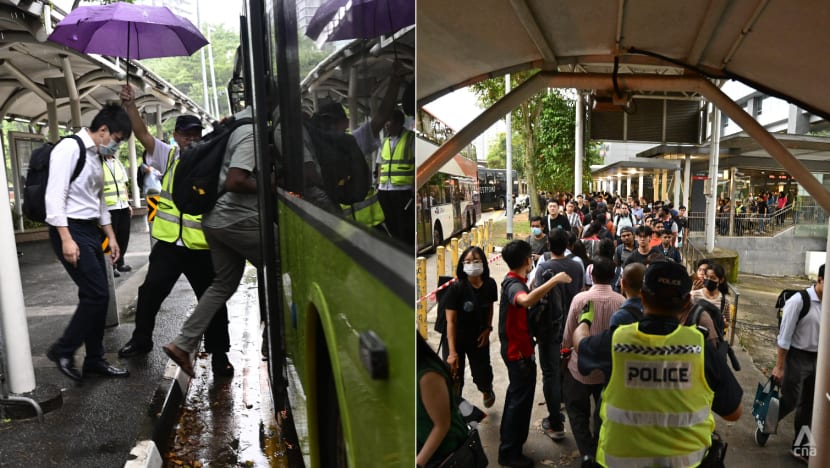Commuters cope with rain, longer journeys on day 2 of East-West Line MRT disruption

An SBS Transit staff member holding an umbrella to shield commuters from the rain (left), while a long queue for bridging buses formed outside Buona Vista MRT station (right) after a train service disruption. (Photos: CNA/Wallace Woon)

This audio is generated by an AI tool.
SINGAPORE: Many commuters face another challenging journey on Thursday (Sep 26), with train services between Jurong East and Buona Vista stations still unavailable as the disruption that started on Wednesday enters a second day.
In updates on Thursday morning, operator SMRT said that shuttle train services are available between Boon Lay and Jurong East, as well as between Queenstown and Buona Vista stations.
SMRT also said in its updates that free regular bus services are available between Boon Lay and Queenstown stations and that bridging bus services are available between Jurong East and Buona Vista.
The transport operator also encouraged commuters to look out for people with special needs.

In a Facebook post on Thursday morning, the Land Transport Authority (LTA) thanked commuters for their patience during the peak hour commute, which coincided with rain.
It added that it had been working closely with SMRT, SBS Transit and Tower Transit to provide bus bridging services and on-ground crowd management.
"We kindly urge commuters to remain patient and maintain orderliness while waiting for the buses as we continue working on our recovery efforts," said LTA.
MORNING SITUATION
At Buona Vista MRT station at about 6.30am, CNA saw at least five buses offering bridging services at the bus stop and crowds were starting to form.
Staff were seen ushering commuters onto the buses.

By 7am, the number of passengers arriving at Buona Vista MRT station had increased, with a few commuters seen running towards the bridging bus point.
However, the situation remained calm at the bridging bus point with buses arriving and departing every minute, and the queue moving quickly.

At about 7.10am, queues started swelling at Buona Vista MRT station's bus bridging point.
CNA noted that there were snaking queues stretching at least 100m.


Mohamed Fayyaz, a commuter, told CNA he had left for work 20 minutes earlier than usual, in anticipation of Thursday’s disruption.
He was travelling from Kallang to Choa Chu Kang, a journey that would normally take him about 1.5 hours.
Due to the disruption, he had to take the East-West Line train from Kallang to Buona Vista, followed by a bridging bus to Jurong East and then the North-South Line to Choa Chu Kang.
When CNA spoke to him at 7.30am at Buona Vista MRT station, he had already been travelling for one hour.
“I didn't expect it to be so crowded (at Buona Vista),” said the 23-year-old.
“But I mean, these things happen once in a while.”

Another commuter Wu Xiao Ning expressed disappointment over the disruption.
“Frankly speaking, I think it’s a shame on Singapore … LTA or SMRT spent so many years and cannot solve the problem completely,” he said.
The 45-year-old who works in management said he could not leave for work earlier as he had to wait for his children to go to school.
“I’m definitely going to be late and (have informed my company) that I’ll be, at minimum, one-hour delayed.”

By 8am, it started drizzling at Buona Vista, with dark clouds looming above. SBS transit staff were seen holding umbrellas up to shield passengers from the rain as they boarded the bridging buses.
At about 8.15am, traffic started building up along North Buona Vista road, with numerous bridging buses plying the road.
SBS transit staff could be heard telling passengers to move towards the rear of the bus so that more passengers can get on.
“Please move in, if you can. It’s raining. Please move in,” said one SBS transit staff.
CNA observed at least 90 passengers in each bridging bus.
CNA also noted that the situation was still relatively orderly and queues were moving quickly, with no flaring tempers or shouting commuters.
By 9am, the crowd had significantly subsided at Buona Vista with just dozens waiting for the bridging buses.

SMRT, SBS Transit staff and police at Buona Vista were seen working tirelessly all morning to ensure that things moved smoothly.
CNA observed SBS transit staff getting soaked in the rain as they held out umbrellas for passengers while they entered the bridging buses.
At the train platform, SMRT staff could be heard giving directions to passengers every few seconds.
One SMRT staff who had been at the station since CNA arrived at 6.30am, looked visibly exhausted when CNA spotted him again at 9.45am.
He crouched down to take a quick sip of water, clutching his throat, before raising his megaphone again to repeat directions to passengers.


Over at Jurong East, at least four bridging buses were lined up near the MRT station at around 7am. Passengers were seen calmly getting onto the buses, as SMRT staff informed them that the buses would bring them to Clementi, Dover and Buona Vista.
At around 7.10am, queues started to form at the bus bridging point near the MRT station. Staff were heard telling commuters to fill up the upper deck of the bus.
One commuter, who only gave his name as Rex, said this was his first time experiencing the train disruption that has spanned over two days.
However, the 32-year-old said he was “not concerned” about the situation as he made his way towards the bus bridging point from Jurong East MRT station at around 7.40am.
Mr Rex told CNA his work starts at 9am and that there was “enough time” to get there.

It started drizzling around 8am near Jurong East MRT but commuters were undeterred as they made their way to the bridging buses.
Longer queues also started to form at the bridging point near Jurong East MRT station at around 8.15am.
But there were no signs of agitation from the commuters as they waited for their turn to get on the bridging buses.

Ms Angela Fababeir was making her way to her office in Commonwealth, with a few minutes to spare before work started at 8am.
The 21-year-old, who works in the building and environment sector, told CNA that staff at her workplace were given an additional 15-minute grace period to come in due to the train disruption.
Ms Fababeir said that it was “super crowded” the day before when she was heading back to her home in Sembawang during peak hours.
“Yesterday was like really hectic and messy because you come out of work, you don’t know what’s going on.
“We checked our phones and the news just nice popped up … At least today it’s a little bit more organised,” she said.
However, Ms Fababeir did face some challenges on the second day. “There was more manpower below to tell you where to go and what to do.
“Whereas on the platform, it was very crowded so I couldn’t see the people helping out.”
CNA noticed a passer-by who was visibly irritated as she tried to comb her way through the crowd of commuters waiting for the bridging buses. She was heard saying that “people needed to go home”.


TRACTION POWER FAULT
Disruptions on the segment of the East-West Line affecting nine stations began as early as 9.25am on Wednesday after a train caused a power trip when it was returning to Ulu Pandan depot.
This caused a train near Clementi station to stall, and about 850 commuters on this train had to disembark on the tracks and be guided back to the station platform.
From then, regular train services were not available at the nine stations - Boon Lay, Lakeside, Chinese Garden, Jurong East, Clementi, Dover, Buona Vista, Commonwealth and Queenstown - in both directions.
On Wednesday evening, commuters experienced transport delays during rush hour. CNA teams on the ground noted that despite the lines and crowds, the situation was mostly orderly.
This is the longest train disruption since 2017.
On Oct 7, 2017, a heavy downpour led to a flooded tunnel between Braddell and Bishan MRT stations, and train services on the North-South Line were shut down for more than 20 hours.
About a month later on Nov 15, 2017, a train collision at Joo Koon MRT station injured 28 people. It prompted a three-day suspension of train services from Joo Koon to Tuas Link on the East-West Line.



















